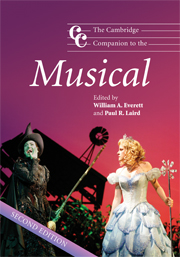Book contents
- Frontmatter
- Part I Adaptations and transformations: before 1940
- Part II Maturations and formulations: 1940–1970
- Part III Evolutions and integrations: after 1970
- 11 Stephen Sondheim and the musical of the outsider
- 12 Choreographers, directors and the fully integrated musical
- 13 From Hair to Rent: is ‘rock’ a four-letter word on Broadway?
- 14 The megamusical: the creation, internationalisation and impact of a genre
- 15 ‘Something borrowed, something blue’: the marriage of the musical and Europe
- 16 New horizons: the musical at the dawn of the twenty-first century
- Part IV Legacies and transformations
- Notes
- Select bibliography
- Index
16 - New horizons: the musical at the dawn of the twenty-first century
from Part III - Evolutions and integrations: after 1970
Published online by Cambridge University Press: 28 September 2011
- Frontmatter
- Part I Adaptations and transformations: before 1940
- Part II Maturations and formulations: 1940–1970
- Part III Evolutions and integrations: after 1970
- 11 Stephen Sondheim and the musical of the outsider
- 12 Choreographers, directors and the fully integrated musical
- 13 From Hair to Rent: is ‘rock’ a four-letter word on Broadway?
- 14 The megamusical: the creation, internationalisation and impact of a genre
- 15 ‘Something borrowed, something blue’: the marriage of the musical and Europe
- 16 New horizons: the musical at the dawn of the twenty-first century
- Part IV Legacies and transformations
- Notes
- Select bibliography
- Index
Summary
During most of the 1960s, it was easy to see the musical as hopelessly out of touch with contemporary America. Even with three Broadway blockbusters opening in the same year (1964) – Fiddler on the Roof, Hello, Dolly!, Funny Girl – and the film version of My Fair Lady walking away with eight Academy Awards – it seemed apparent that the Golden Age of Musical Theatre had staged its own grand finale as these works neither reflected nor commented on the turmoil of the 1960s; they were escapist and nostalgic. With the assassinations of President John F. Kennedy (1963), Martin Luther King (1968) and Senator Bobby Kennedy (1968), and the escalating war in Vietnam, the world was a different place from the comparative calm of the 1950s. In 1964, the Beatles appeared on the Ed Sullivan Show for the first time, heralding with electronic chords that the British invasion was in full force, and rock ‘n’ roll was here to stay. As urban centres across the county fell into disrepair, many downtown theatres were abandoned (often to the wrecking ball) and the road business of touring musicals almost ceased altogether. Financially and artistically, the fabulous invalid was not in very good shape.
When Hair arrived on Broadway in 1968, the Great White Way at last embraced a musical whose music and sentiment reflected some of the headlines of its day, and it was staged in a way that distanced itself aesthetically light years away from other musicals playing around Times Square. With the New York premieres of Stephen Sondheim’s Company (1970), Andrew Lloyd Webber’s Jesus Christ Superstar (1971), Michael Bennett’s A Chorus Line (1975), and John Kander, Fred Ebb and Bob Fosse’s Chicago (1975), several new artists found audiences for their disparate visions of what a musical could be, sing and/or dance about. Experimentation continued as the concept musical, the jukebox musical, the revisal, the dansical and the megamusical came to be.
- Type
- Chapter
- Information
- The Cambridge Companion to the Musical , pp. 284 - 302Publisher: Cambridge University PressPrint publication year: 2008
- 2
- Cited by



